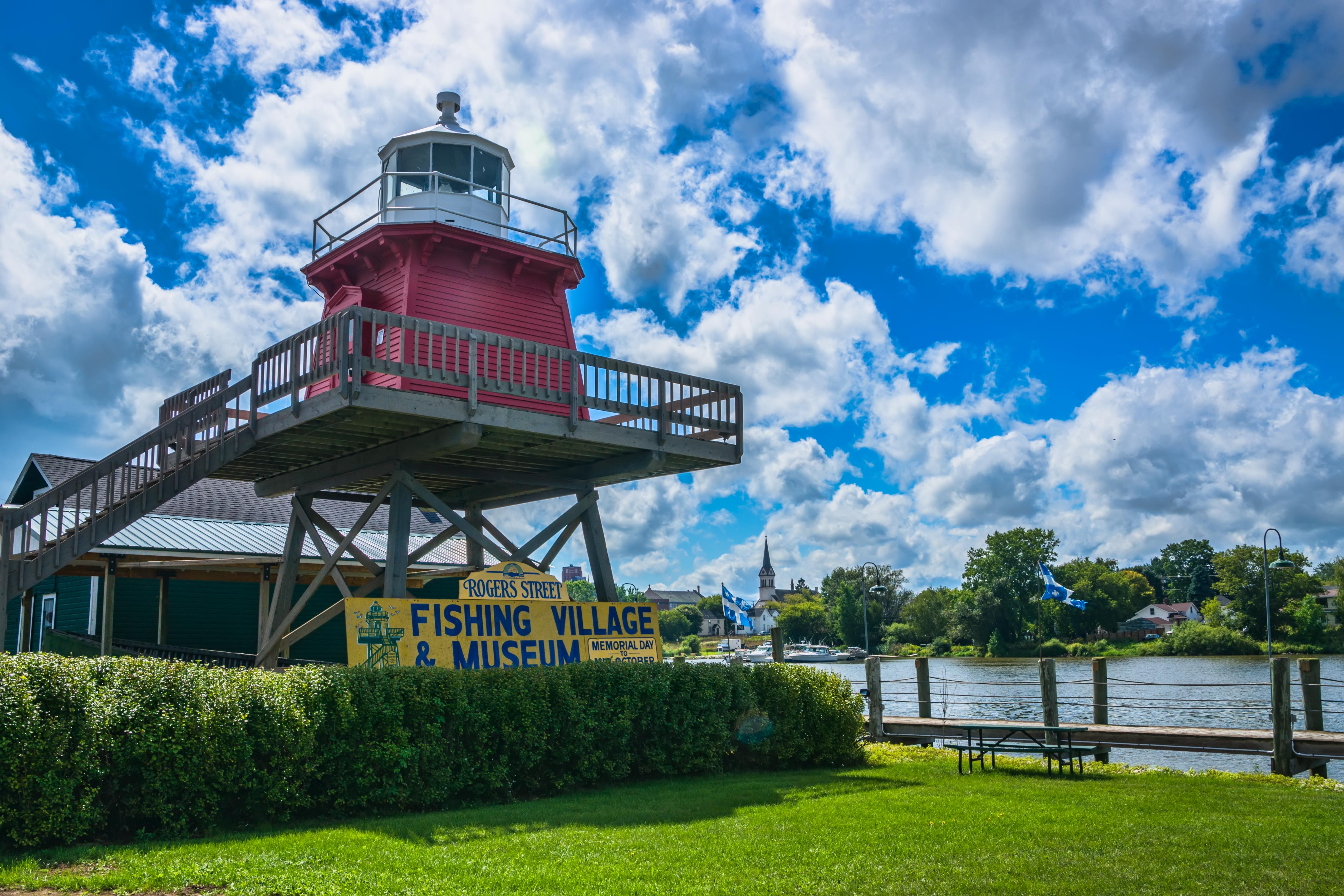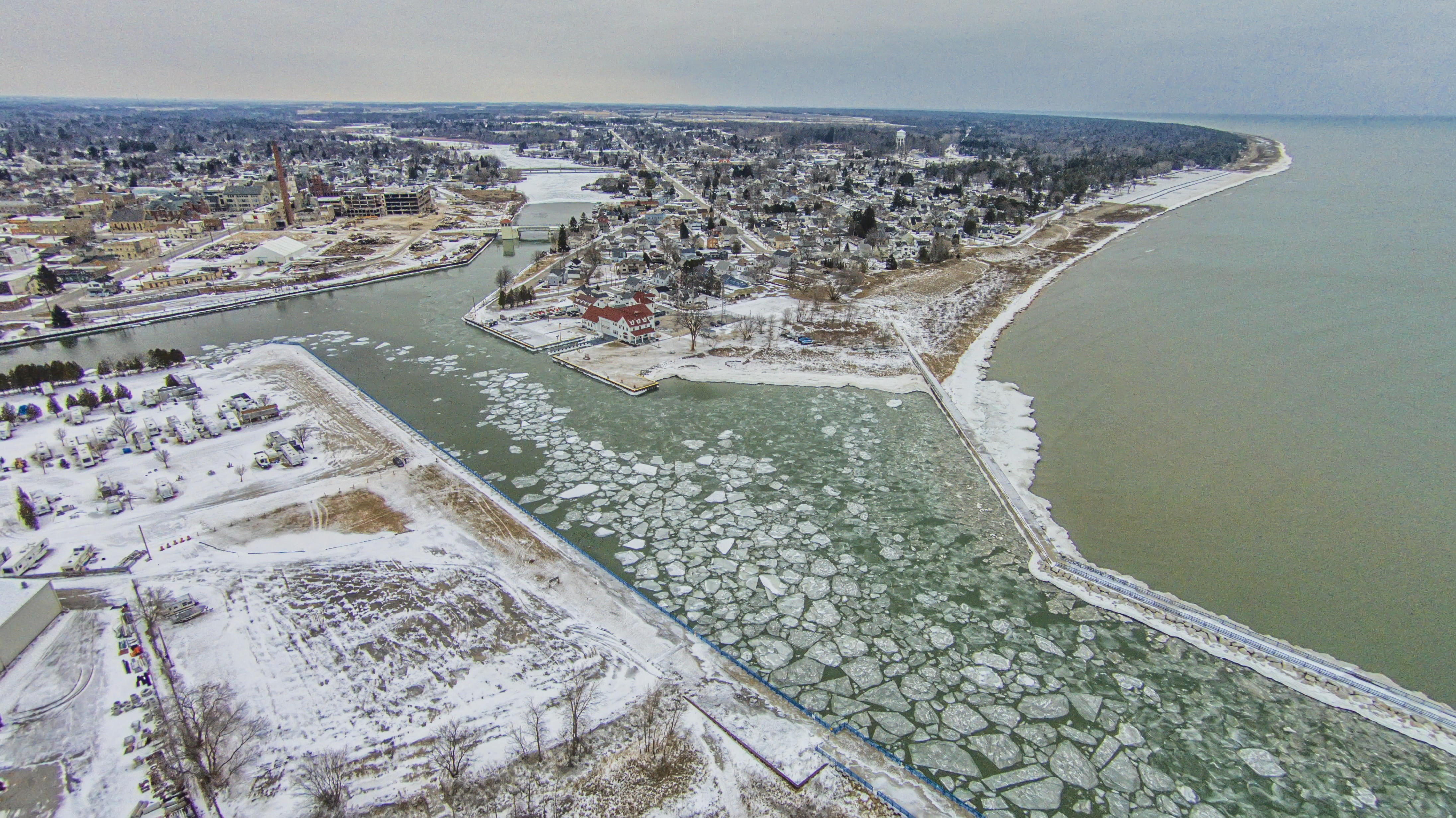|
Two Rivers Light
The Two Rivers Light (also known as the Two Rivers North Pierhead Light) is a lighthouse formerly located at the harbor entrance to Two Rivers, Wisconsin. It is now located in a museum in the city. History This light was preceded by a brick structure on shore, one and a half stories with a cupola. This light was erected in 1852 and lasted only until 1858. A project to improve the harbor was begun in 1870, including the construction in stages of a pair of Breakwater (structure), breakwaters defining the entrance channel. In 1886 a lighthouse was built at the end of the northern breakwater. A simple pyramidal wooden tower was constructed, consisting of a watch room on an open timber framework surmounted by the lantern. A sixth-order Fresnel lens was provided as the light source, displaying a fixed red light. This light contained no dwelling. The Rawley Point Light keeper tended it, accessing the light via a long catwalk running the length of the pier. The light was damaged in the f ... [...More Info...] [...Related Items...] OR: [Wikipedia] [Google] [Baidu] |
Fresnel Lens
A Fresnel lens ( ; ; or ) is a type of composite compact lens (optics), lens which reduces the amount of material required compared to a conventional lens by dividing the lens into a set of concentric annular sections. The simpler Dioptrics, dioptric (purely refraction, refractive) form of the lens was first proposed by Georges-Louis Leclerc, Comte de Buffon, and independently reinvented by the French physicist Augustin-Jean Fresnel (1788–1827) for use in lighthouses. The Catadioptric system, catadioptric (combining refraction and reflection) form of the lens, entirely invented by Fresnel, has outer Prism (optics), prismatic elements that use total internal reflection as well as refraction to capture more oblique light from the light source and add it to the beam, making it visible at greater distances. The design allows the construction of lenses of large aperture and short focal length without the mass and volume of material that would be required by a lens of conventional ... [...More Info...] [...Related Items...] OR: [Wikipedia] [Google] [Baidu] |
Lighthouse
A lighthouse is a tower, building, or other type of physical structure designed to emit light from a system of lamps and lens (optics), lenses and to serve as a beacon for navigational aid for maritime pilots at sea or on inland waterways. Lighthouses mark dangerous coastlines, hazardous shoals, reefs, rocks, and safe entries to harbors; they also assist in aerial navigation. Once widely used, the number of operational lighthouses has declined due to the expense of maintenance and the advent of much cheaper, more sophisticated, and more effective electronic navigational systems. History Ancient lighthouses Before the development of clearly defined ports, mariners were guided by fires built on hilltops. Since elevating the fire would improve visibility, placing the fire on a platform became a practice that led to the development of the lighthouse. In antiquity, the lighthouse functioned more as an entrance marker to ports than as a warning signal for reefs and promontory, prom ... [...More Info...] [...Related Items...] OR: [Wikipedia] [Google] [Baidu] |
Two Rivers, Wisconsin
Two Rivers is a city in Manitowoc County, Wisconsin, United States. The population was 11,271 at the 2020 census. It claims to be the birthplace of the ice cream sundae (though other cities, such as Ithaca, New York, make the same claim). The city's advertising slogan is "Catch our friendly waves" as it is located along Lake Michigan. History A post office called Two Rivers has been in operation since 1848. The city was named from its location at the confluence of the Mishicot and Neshota rivers, now known as the East Twin and West Twin Rivers, respectively. Geography Two Rivers derives its name from the East Twin River and the West Twin River which meet in the city less than a mile from their outflows at Lake Michigan. Two Rivers is located at (44.154928, −87.57642). According to the United States Census Bureau, the city has a total area of , of which, is land and is water. Highways * WIS 42 Northbound travels to Kewaunee and Sturgeon Bay. South it continues into ... [...More Info...] [...Related Items...] OR: [Wikipedia] [Google] [Baidu] |
Two Rivers Lighthouse
2 (two) is a number, numeral and digit. It is the natural number following 1 and preceding 3. It is the smallest and the only even prime number. Because it forms the basis of a duality, it has religious and spiritual significance in many cultures. Mathematics The number 2 is the second natural number after 1. Each natural number, including 2, is constructed by succession, that is, by adding 1 to the previous natural number. 2 is the smallest and the only even prime number, and the first Ramanujan prime. It is also the first superior highly composite number, and the first colossally abundant number. An integer is determined to be even if it is divisible by two. When written in base 10, all multiples of 2 will end in 0, 2, 4, 6, or 8; more generally, in any even base, even numbers will end with an even digit. A digon is a polygon with two sides (or edges) and two vertices. Two distinct points in a plane are always sufficient to define a unique line in a nont ... [...More Info...] [...Related Items...] OR: [Wikipedia] [Google] [Baidu] |
Breakwater (structure)
A breakwater is a permanent structure constructed at a coastal area to protect against tides, currents, waves, and storm surges. Breakwaters have been built since antiquity to protect anchorage (maritime), anchorages, helping isolate vessels from marine hazards such as wind-driven waves. A breakwater, also known in some contexts as a jetty or a Mole_(architecture), mole, may be connected to land or freestanding, and may contain a walkway or road for vehicle access. Part of a coastal management system, breakwaters are installed parallel to the shore to minimize erosion. On beaches where longshore drift threatens the erosion of beach material, smaller structures on the beach may be installed, usually perpendicular to the water's edge. Their action on waves and current is intended to slow the longshore drift and discourage mobilisation of beach material. In this usage they are more usually referred to as groynes. Purposes Breakwaters reduce the intensity of wave action in ins ... [...More Info...] [...Related Items...] OR: [Wikipedia] [Google] [Baidu] |
Rawley Point Light
Rawley Point Light (also known as Twin River Point Light) is a lighthouse located in Point Beach State Forest, near Two Rivers, Wisconsin. At tall, it is the tallest lighthouse on the Wisconsin Shore and it is listed on the National Register of Historic Places. History Rawley Point is named after Peter Rowley, who established a trading post in the area in 1835. Some accounts say that a light was established here as early as 1853, a tall arrangement of four poles holding a lantern; this was succeeded by a wooden house and tower. This structure proved ill-placed, and a more substantial building was erected beginning in 1873, consisting of a brick house with an attached tower, about tall, in which was mounted a third order Fresnel lens. This light went into service on December 7, 1874. In 1890 a steam fog whistle was added, and in 1893 a circular oil house was built. The brick tower was not structurally sound, and in 1892 it was strengthened. This continued to be unsatisfactory, ... [...More Info...] [...Related Items...] OR: [Wikipedia] [Google] [Baidu] |
Lighthouses Completed In 1852
A lighthouse is a tower, building, or other type of physical structure designed to emit light from a system of lamps and lenses and to serve as a beacon for navigational aid for maritime pilots at sea or on inland waterways. Lighthouses mark dangerous coastlines, hazardous shoals, reefs, rocks, and safe entries to harbors; they also assist in aerial navigation. Once widely used, the number of operational lighthouses has declined due to the expense of maintenance and the advent of much cheaper, more sophisticated, and more effective electronic navigational systems. History Ancient lighthouses Before the development of clearly defined ports, mariners were guided by fires built on hilltops. Since elevating the fire would improve visibility, placing the fire on a platform became a practice that led to the development of the lighthouse. In antiquity, the lighthouse functioned more as an entrance marker to ports than as a warning signal for reefs and promontories, unlike many moder ... [...More Info...] [...Related Items...] OR: [Wikipedia] [Google] [Baidu] |




